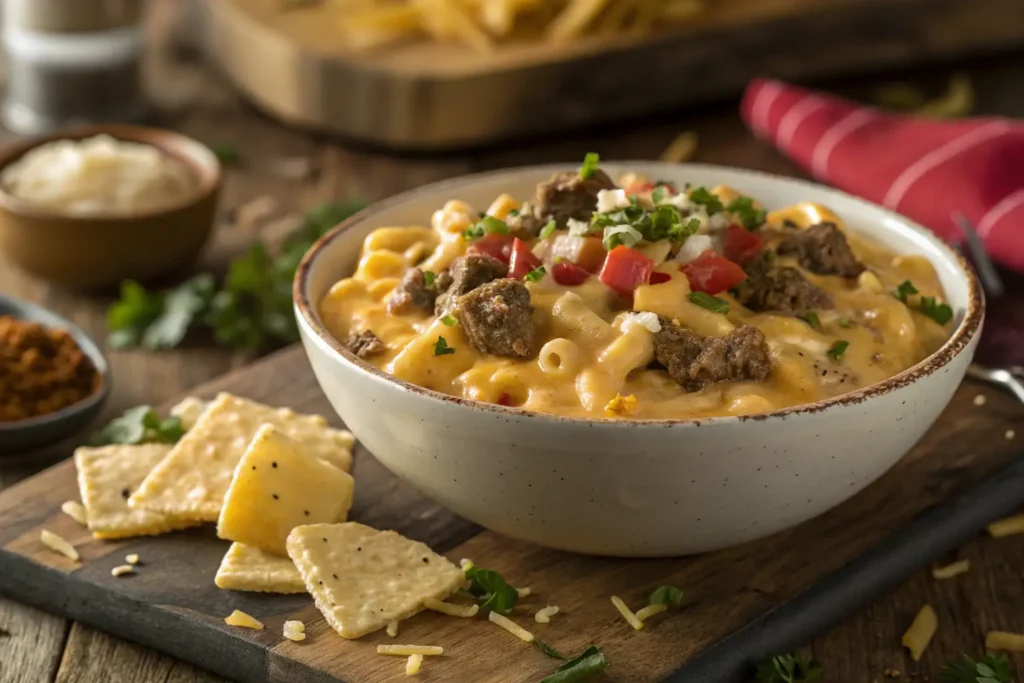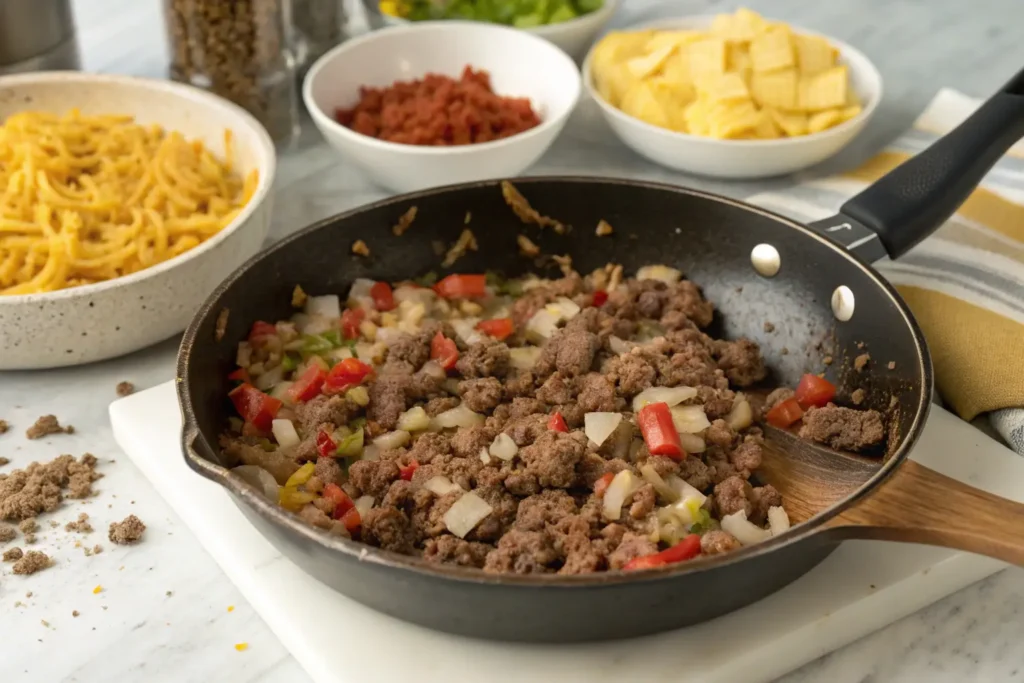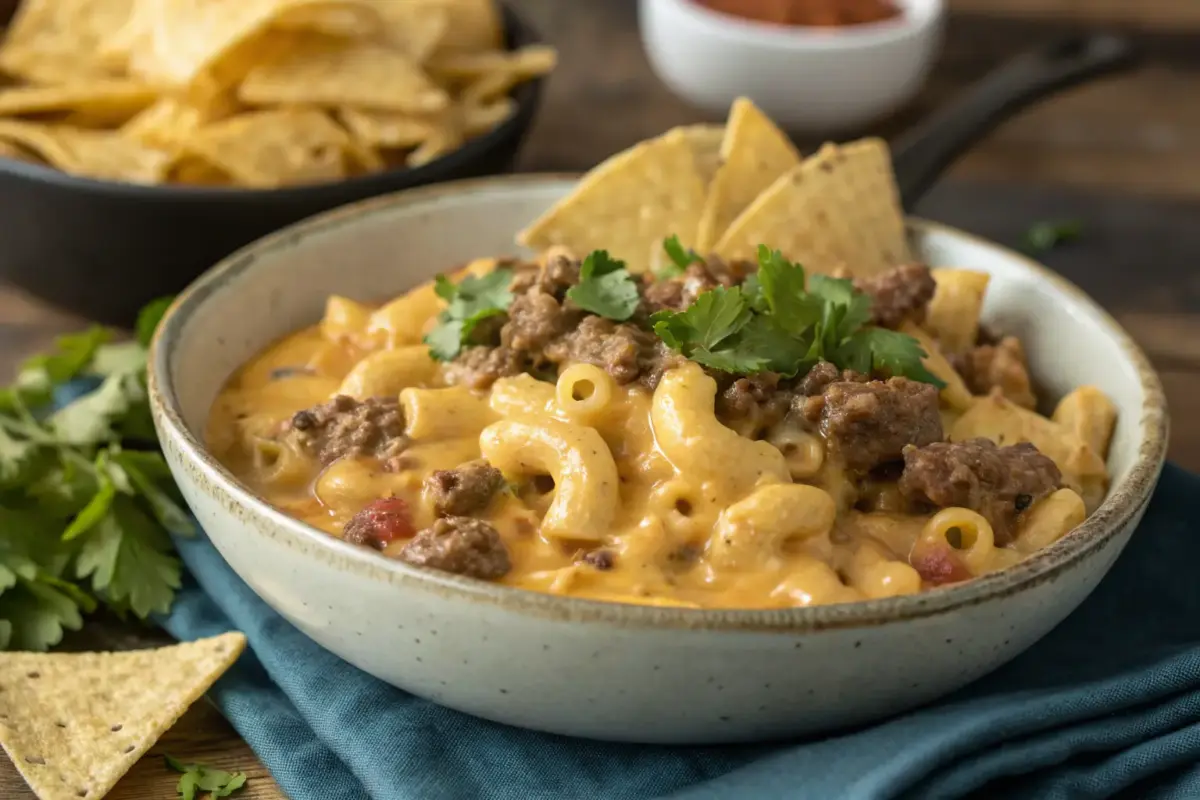Introduction to Beef Queso Mac and Cheese
Let’s be real—comfort food doesn’t get much better than mac and cheese. But when you add beef and queso to the mix? You’re stepping into next-level deliciousness. Beef queso mac and cheese combines the creamy, cheesy goodness we all love with the savory kick of seasoned beef and the bold flavors of queso. It’s the perfect dish for game day, family dinners, or when you’re just craving something indulgent.
This recipe brings together two iconic comfort foods: mac and cheese and queso dip. The result? A hearty, flavorful meal that’s impossible to resist. Plus, it’s surprisingly easy to make, even for beginners. Let’s dig into what makes this dish so special!
What Makes This Dish Unique?
Beef queso mac and cheese isn’t your standard pasta dish. First off, it’s loaded with bold flavors—think smoky spices, creamy cheese, and tender, juicy ground beef. Second, it’s endlessly customizable. Whether you like it mild or spicy, loaded with veggies, or extra cheesy, there’s room to make it your own. Finally, it’s a one-pot wonder (well, mostly), making cleanup a breeze.
What really sets this recipe apart, though, is its ability to combine comfort and excitement. It’s nostalgic yet modern, satisfying both your cravings for something hearty and your curiosity for a fusion of flavors.
A Quick History of Mac and Cheese Fusion Recipes
Mac and cheese has been a beloved staple in American kitchens for decades. From boxed versions to gourmet restaurant takes, this dish never goes out of style. In recent years, chefs and home cooks alike have started experimenting with fusion recipes—adding everything from barbecue to buffalo chicken to elevate this classic.
Beef queso mac and cheese fits right into this trend. By incorporating elements of Tex-Mex cuisine (hello, queso!) with the traditional creaminess of mac and cheese, it creates a hybrid that’s both familiar and exciting. It’s a testament to how versatile mac and cheese can be—and why it’s still one of America’s favorite comfort foods.
Key Ingredients for Beef Queso Mac and Cheese
Choosing the Best Ground Beef for Flavor
The foundation of this dish starts with the ground beef. You’ll want to use beef that’s not too lean, as a bit of fat helps enhance the flavor. An 80/20 blend (80% lean, 20% fat) is a great option. If you’re looking for a slightly healthier twist, you can opt for ground turkey or chicken, but keep in mind that the flavor profile will change slightly.
Don’t forget to season the beef well! A mix of garlic, onion powder, paprika, and cumin will give it that Tex-Mex flair. If you like it spicy, toss in some chili powder or cayenne pepper. Pro tip: brown the beef in a hot pan to get those delicious crispy bits that add texture and flavor.
Perfect Cheese Combinations for Queso

The queso is the star of this dish, so choosing the right cheeses is crucial. A blend of sharp cheddar and Monterey Jack creates a creamy, tangy base that melts beautifully. If you’re feeling adventurous, you can add a touch of pepper jack for some heat or a bit of Velveeta for that silky texture.
For an authentic queso flavor, mix in some canned diced tomatoes with green chilies (like Rotel). These add a slight acidity and a touch of spice that balances out the richness of the cheese. And yes, freshly grated cheese is always better—it melts more smoothly than pre-shredded varieties.
Pasta Selection: Best Shapes for Cheese Absorption
Not all pasta is created equal when it comes to mac and cheese. You want a shape that can hold onto the cheese sauce, ensuring every bite is packed with flavor. Elbow macaroni is the classic choice, but other great options include cavatappi, shells, or penne. These shapes have grooves and curves that trap the sauce, making them perfect for this dish.
Cook the pasta just shy of al dente, as it will continue to soften when mixed with the sauce. And don’t forget to salt your pasta water—it’s an easy way to add extra flavor right from the start.
Essential Tools and Equipment
Best Pots and Pans for Mac and Cheese Cooking
When it comes to cooking beef queso mac and cheese, having the right tools can make all the difference. A large, heavy-bottomed skillet or sauté pan is perfect for browning the beef evenly and creating a flavorful base. Cast iron is a great choice because it retains heat well, but any sturdy pan will do the trick.
For the pasta, a roomy pot with plenty of water is key. You want enough space for the pasta to move around freely while cooking. And don’t forget a colander for draining—it’s one of those tools you don’t think about until you need it!
Efficient Cheese Melting Techniques
Melting cheese can be tricky if you’re not careful, but a few tips can help you avoid a clumpy or greasy mess. First, always shred your cheese fresh from the block. Pre-shredded cheese often contains additives that prevent it from melting smoothly.
Use low, steady heat when making the queso sauce. Start by creating a roux (a simple mix of butter and flour) to thicken the sauce. Slowly add warm milk, whisking constantly to prevent lumps. Once the mixture is smooth, gradually add the cheese, stirring as you go. This step-by-step approach ensures a creamy, velvety sauce every time.
Step-by-Step Recipe Breakdown
Preparing the Ground Beef for Maximum Flavor

Start by heating a tablespoon of oil in your skillet over medium-high heat. Once it’s hot, add the ground beef, breaking it up with a spatula as it cooks. Sprinkle in your seasoning blend—paprika, cumin, garlic powder, onion powder, and a pinch of salt and pepper work beautifully.
Cook the beef until it’s browned and slightly crispy around the edges. Don’t rush this step! The browned bits at the bottom of the pan are packed with flavor. Once the beef is done, drain any excess grease if necessary, and set it aside while you prepare the rest of the dish.
Creating the Perfect Queso Cheese Sauce
Now it’s time to tackle the queso. In the same skillet, melt a few tablespoons of butter over medium heat. Sprinkle in an equal amount of flour and whisk constantly until the mixture turns golden—this is your roux. Gradually pour in warm milk, whisking the entire time to create a smooth, creamy base.
Once the milk mixture thickens, start adding your shredded cheese a handful at a time. Stir after each addition to ensure the cheese melts completely before adding more. Finally, toss in a can of diced tomatoes with green chilies for that signature queso flavor. Stir until everything is combined and silky smooth.
Combining Ingredients for Creamy Perfection
With the beef and queso ready, it’s time to bring it all together. Add your cooked pasta to the skillet, stirring gently to coat every piece in that luscious cheese sauce. Fold in the ground beef, making sure it’s evenly distributed throughout the dish.
If you want to take it up a notch, transfer the mac and cheese to a baking dish, sprinkle some extra cheese on top, and broil it for a few minutes. The golden, bubbly crust is worth the extra step!
Variations to Elevate Your Dish
Spicy Twists with Jalapeños and Chipotle
For those who love a bit of heat, adding jalapeños or chipotle peppers can give your dish a bold kick. Dice fresh jalapeños and sauté them with the beef, or stir in a spoonful of chipotle in adobo sauce for a smoky, spicy flavor. If you’re feeling daring, top the finished dish with sliced pickled jalapeños for an extra zing.
Adding Vegetables for a Nutritional Boost
Who says comfort food can’t be nutritious? Adding vegetables to your mac and cheese is an easy way to sneak in some extra vitamins. Try stirring in cooked broccoli, roasted bell peppers, or even spinach. These veggies not only add color but also complement the rich, cheesy sauce beautifully.
Alternative Cheese Options for Different Tastes
If you want to switch things up, there are plenty of cheese options to explore. Gouda adds a subtle smokiness, while blue cheese gives a sharp, tangy edge. You can even experiment with dairy-free cheeses if you’re catering to a specific diet. Just be sure to adjust the ratios to keep the sauce smooth and creamy.
Serving Suggestions
Pairing with the Perfect Sides
Beef queso mac and cheese is a hearty dish on its own, but pairing it with the right sides can create a complete, balanced meal. For something fresh, a crisp green salad with a tangy vinaigrette works wonders to cut through the richness. Garlic bread or warm tortillas are excellent for soaking up any leftover sauce—because let’s face it, you won’t want to waste a drop!
If you’re serving this for a crowd or a party, consider adding Tex-Mex-inspired sides like guacamole, salsa, or corn on the cob. These additions not only enhance the flavors but also give your meal a fun, festive vibe.
Presentation Tips for a Restaurant-Style Appeal
You don’t need fancy plating skills to make this dish look irresistible. Serve it in a cast-iron skillet for a rustic, homestyle feel, or plate it in individual ramekins for a more polished presentation. Sprinkle some chopped cilantro or green onions on top for a pop of color, and add a dollop of sour cream or a drizzle of hot sauce for extra flair.
If you’ve gone the extra mile with a broiled cheese crust, let it speak for itself. The golden, bubbly topping is a showstopper that’s sure to impress!
Storage and Reheating Tips
How to Keep Your Mac and Cheese Fresh
Leftovers? Lucky you! To store your beef queso mac and cheese, transfer it to an airtight container and refrigerate it within two hours of cooking. This helps maintain its freshness and prevents any food safety issues. It’s best to enjoy it within 3-4 days, though let’s be honest—it rarely lasts that long!
If you want to freeze it, portion it into freezer-safe containers. While freezing may slightly alter the texture, the flavors will remain delicious. Thaw in the refrigerator overnight before reheating.
Reheating Without Losing Creaminess
The trick to reheating mac and cheese is adding a splash of milk or cream to revive its creamy texture. Warm it gently on the stove over low heat, stirring frequently, or microwave it in short intervals, stirring between each to prevent drying out. If you froze the dish, reheating it in the oven covered with foil can help lock in moisture.
FAQs
What happens if you put too much cheese in mac and cheese?
Adding too much cheese might seem like a good idea (because who doesn’t love cheese?), but it can actually make your mac and cheese overly heavy or greasy. The sauce may lose its smooth, creamy texture and become clumpy. To avoid this, stick to the recommended cheese ratio and mix it gradually into the sauce.
Is queso cheese a good melting cheese?
Yes, queso cheese is fantastic for melting! Most queso recipes use cheeses like Monterey Jack, cheddar, or even Velveeta, all of which melt smoothly and evenly. These cheeses create a silky texture perfect for dipping or for making dishes like beef queso mac and cheese.
How long can cooked mac and cheese sit out?
Cooked mac and cheese shouldn’t sit out at room temperature for more than two hours. After that, bacteria can start to grow, which might make it unsafe to eat. If you’re serving it buffet-style, consider using a warming tray to keep it hot and within a safe temperature range.
How long does it take for mac and cheese to go bad?
Refrigerated mac and cheese typically stays good for 3-4 days if stored properly in an airtight container. If it smells off, has a slimy texture, or shows any signs of mold, it’s time to toss it. For frozen mac and cheese, aim to eat it within 1-2 months for the best quality.
Conclusion
Why Beef Queso Mac and Cheese Deserves a Spot on Your Menu
Beef queso mac and cheese isn’t just another pasta dish—it’s an experience. With its creamy cheese sauce, savory beef, and Tex-Mex flair, it’s the ultimate comfort food with a bold twist. Whether you’re cooking for a crowd, feeding your family, or treating yourself to something indulgent, this dish is a guaranteed hit.
Plus, it’s versatile, easy to make, and endlessly customizable. From spicy add-ins to veggie-packed variations, you can tailor it to suit your taste. So why not give it a try? Your taste buds—and anyone lucky enough to share the table with you—will thank you.
Discover a Classic Favorite!
Try our Old Fashioned Baked Macaroni and Cheese recipe—a timeless dish with rich, cheesy flavors and a golden, crispy top. Perfect comfort food for any occasion!


3 thoughts on “Beef Queso Mac and Cheese: 5 Reasons It’s the Ultimate Comfort Food Recipe”